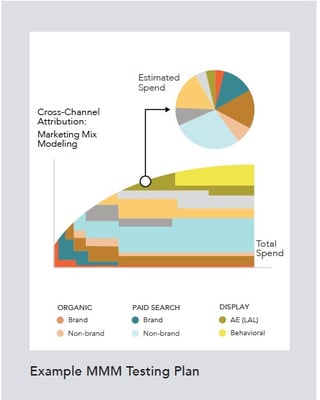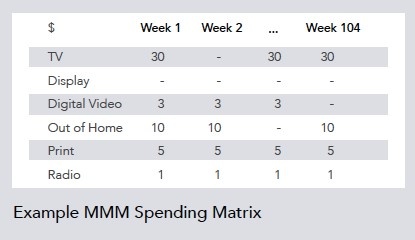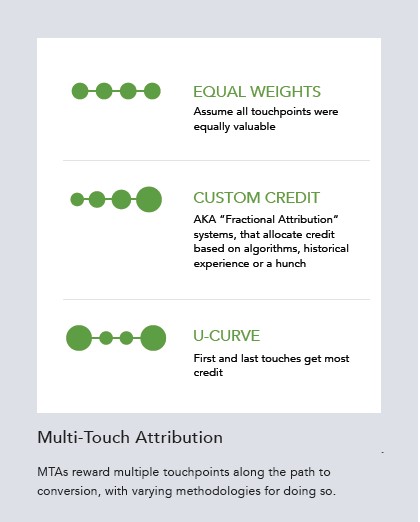Marketing Attribution Models: How Did We Get Here? A History of Measurement

Our first installment of in our series on attribution, The Light at the End of the Tunnel, we shared a summary of the shortfalls, or opportunities we encountered in our discussions with marketers and other industry experts, in search of better measurements to uncover inefficiencies and find hidden opportunities in their marketing efforts.
In this installment of our Attribution Buyers Guide series we will try to define the many different categories of marketing attribution: Marketing Mix Models, Lift Studies, Multi-Touch Attribution models, and the newly minted “Unified Measurement” (Forrester’s descriptor) or “Total Marketing Measurement” (Gartner’s descriptor). Let’s start our journey.
Where Marketing Attribution All Started: Marketing Mix Models
To go back to basics, we have to answer the questions of what is marketing mix modeling (MMM)? Marketing mix modeling can be defined as a strategy to understand how each component of marketing is contributing to sales. By applying regression analysis to historical sales data, marketers used MMMs to analyze the effects of changing different marketing activities.

Marketing Mix Models (MMMs) can trace their roots to the 1950s and became popular in the 1980s. This approach has its merits, including the potential use of at least partially controlled experiments, and its cross-channel coverage of all media types. These are important aspects of an attribution model! MMM’s biggest strength, however, has been a lack of alternatives. Many marketers still use MMMs for top-level media planning and budgeting, mostly because they haven’t caught up with some of the recent innovations that expand and build on what’s great about these older attribution solutions.
As useful of a tool as MMMs have been however, they have numerous shortfalls including:
Too Slow
Results are usually only available weeks after rather than during the campaign.
Overly Behaviorally-Centered
Brand equity is poorly measured by MMMs, if at all. This leads to overspending on lower funnel activity and under-spending in developing the brand among people who need more education and motivation to act. Because of this, MMMs are not a good tool if your company needs to launch a brand campaign.
Absence of the Critical Role of Message and Targeting
The media is a container holding a message, delivered to a specific audience. Change the message, or change the people the message goes to, and the media impact changes dramatically — but mix models miss this critical element of how advertising works. MMMs fail to optimize message and targeting first, before recommending the optimal media mix.
 Lack of Detail
Lack of Detail
MMMs bucket impressions into groups such as Facebook or Prime Time TV, thereby losing significant optimization opportunity. This lack of detail is particularly problematic for media with small reach. Since they measure at an overall aggregated level, a marketing activity that only reaches a small percentage of people may have an impact which is not statistically significant once averaged with all the people not reached. This problem was particularly pronounced for digital media measurement, and led to two separate solutions to the short-comings.
The Half-Step Forward: Digital Attribution Models
Emergence of Multi-Touch Attribution (“MTAs”)
With MMMs failing to help digital marketers, “last click” and “last-touch” emerged. They assigned full credit to the final ad click or exposure, respectively, prior to a consumer’s purchase action. These activities could be measured by an advertiser’s third-party ad server in places where the ad server’s pixels could be fired. Limitations were numerous. “Last-touch” method fails to capture the value of many other factors that may have contributed to the desired behavior, or understand if that behavior might have happened in the absence of the advertisement “touch.”
It may come as a surprise to many that 12% of marketers self-reported as using a last-touch model in 2016. You know who you are, but don’t worry, help is on the way!
Product innovations later in the decade enabled marketers to apply custom weightings, or “fractional attribution,” to recognize the value that different touchpoints may have had in shaping a user’s decisions.
 Ad servers began to develop support for this fractional attribution, and a new category of services designed specifically for ad effectiveness measurement, or attribution, emerged as well. Path-to-purchase became popular, allowing marketers to see the steps leading up to a purchase at an individual person-level. However, this correlation analysis has created flaws, which we’ll address in the next article in the series, which promotes the importance of person-centric marketing.
Ad servers began to develop support for this fractional attribution, and a new category of services designed specifically for ad effectiveness measurement, or attribution, emerged as well. Path-to-purchase became popular, allowing marketers to see the steps leading up to a purchase at an individual person-level. However, this correlation analysis has created flaws, which we’ll address in the next article in the series, which promotes the importance of person-centric marketing.
Attribution Models filled gaps left by MMMs, including the ability to measure in much greater detail, at a person-level. This enabled much more granular analysis of what’s working—e.g. targeting strategies, creative, time of day, etc.
While Multi-Touch Attribution (MTA) significantly improves digital measurement compared to mix modeling, Gartner points out that many marketers have become disillusioned with MTA. Their shortcomings include a poor job at measuring external factors, poor offline media measurement, a lack of connection between brand and sales performance, methodological flaws that compromise conclusions, slow backward-looking results, “location” gaps, and complicated set-up susceptible to cookie deletion. In the single month of May 2014, three of the MTA vendors were acquired. The acquisitions, it can be argued, slowed innovation for the purchased companies. However, it did not stop innovation for the measurement industry.
Lift Studies
If the shortcomings described so far weren’t enough, “Attribution” became a hyped term. What used to be called a “Lift Study” by ad sellers began to be called “Attribution.” These lift studies, which measure the impact of a single media channel in isolation, added to the perception that attribution measurement is incomplete. As the name implies, lift studies apply experimental design to show incremental value (lift over control), which we applaud. However, it’s their single-channel focus that leaves much to be desired.
Lurching Towards the Future: Person-Level Cross-Channel Optimization
In the same way that digital attribution solutions emerged in response to the shortcomings of mix models, person-level cross channel optimization also emerged to address the shortcomings in measuring digital. At the time, digital lift studies using design of experiments had established the incremental value of online advertising. Marketers wanted to know if they should re-allocate budget from TV and other traditional media to digital. MMMs couldn’t answer the question.
The Interactive Advertising Bureau (IAB), The Advertising Research Foundation (ARF), The Association of National Advertisers (ANA), and the Association of American Advertising Agencies (4As) joined together in support of a new methodology for measuring online and offline advertising.
The approach used person-level data to link online advertising to offline sales, to measure branding as well as sales behavior, to measure message impact, path to purchase, and message impact (combined with design of experiments). The method initially controlled for external factors, and eventually applied external factors to the person-level dataset.
Admap wrote up the breakthrough methodology in its October 2005 edition. Leading academics such as University of Chicago Economist and Best-Selling Author of “Freakonomics” Steven Levitt described the method as having “the power to cut through the Gordian knot of advertising and marketing complexity.” It took off from there:
Chicago Economist and Best-Selling Author of “Freakonomics” Steven Levitt described the method as having “the power to cut through the Gordian knot of advertising and marketing complexity.” It took off from there:
- BusinessWeek included results of the method on the cover, in an article entitled “Why Math Will Rock Your World.”
- The Journal of Interactive Marketing published “Integrated Multichannel Communication Strategies” that showed the method used to measure online and offline media down to the person-level, connecting branding and sales.
- ESOMAR (European Society for Opinion and Marketing Research) named the method one of 30 best practices in all of research in their Market Research Best Practice: 30 Visions for the Future(Wiley).
The method was applied globally in dozens of countries.The main shortcomings of the methodology were the complex setup and cost. As the method pre-dated cloud computing, the analysis was data-intensive and computationally costly. It was valuable to the top 50 marketers spending heavily, but at the time, not practical as an “always on” measurement system. Most marketers used the method at a specific point in time to answer looming strategic questions such as the appropriate investment level in digital marketing, social, etc. Arguably, it was a method a decade ahead of its time. Recently, the method has re-emerged in what Gartner calls “Total Marketing Measurement” and Forrester classifies as “Unified Measurement.”

Advances in cloud computing, person-level identity systems, and data availability have made it possible to advance the state of measurement. While there are many more advances to be made, it has never been a better time for data-driven marketers to get the tools they need to be successful.
The Future is Now: Unified Measurement / Total Marketing Measurement
Forrester Research coined the term “Unified Measurement” in their October 2016 Wave Report. Gartner introduced the term “Total Marketing Measurement” at their 2017 Digital Marketing Conference. While there are nuances, the concept in common is the evolution of methods to provide one integrated view of marketing effectiveness. Gartner incorporates a consistent view of the consumer, implying person-level analysis. Forrester encourages a unified view that incorporates the person-level granularity introduced by the MTAs and applies it across all media channels in a way that MTAs historically have not, therefore retaining some of the key virtues of MMM.
Some Unified Marketing Measurement models include “experimental design.” This simultaneously eliminates the “black box” stigma of most MTAs, while eliminating erroneous allocation of credit resulting from correlation-based measurement.
Unified Measurement models also enable marketers to understand the impact of creative in a more granular fashion than previously possible, therefore allowing marketers to understand this important part of the equation. Perhaps most significant is that the Unified Measurement approach introduces new capabilities that become available when marrying the benefits of MMMs and MTAs, thereby creating a 1+1 = 3 effect.
In addition to recommending the Unified Measurement category, Forrester further encourages marketers to evaluate vendors within the category in detail. For example, some vendors specialize in understanding connections between branding and performance; others may integrate both marketing mix modeling and external factors, such as the weather and economy, with the person-level measurement capabilities introduced by MTAs; yet others may differentiate based on their cross-device user graphing. We begin to identify these important attributes in our next article on how to measure marketing on the person-level.
Final Thoughts on Unified Measurement
Marketing attribution models have come a long way since they first emerged in the 1950s with the unified measurement model offering a person-centric approach and real time data. To learn more about how Marketing Evolution can help your company with digital optimization and marketing intelligence as well as how to get the most of your online and offline marketing efforts, contact us today.

